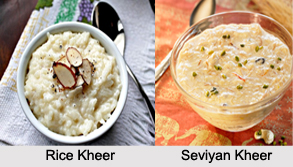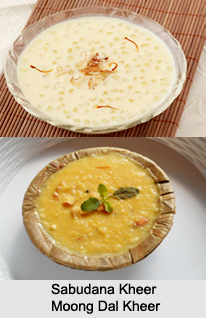 Kheer is a rice pudding from the cuisine of India, made by boiling rice, broken wheat, tapioca, or vermicelli with milk and sugar. It is flavoured with cardamom, raisins, saffron, cashews, pistachios or almonds. It is typically served as a dessert. It is also known in some regions as "Payasam", "Payasa", "Phirni", "Gil-e-Firdaus" and "Fereni".
Kheer is a rice pudding from the cuisine of India, made by boiling rice, broken wheat, tapioca, or vermicelli with milk and sugar. It is flavoured with cardamom, raisins, saffron, cashews, pistachios or almonds. It is typically served as a dessert. It is also known in some regions as "Payasam", "Payasa", "Phirni", "Gil-e-Firdaus" and "Fereni".
Kheer is an essential dish in many Hindu feasts and celebrations. While the dish is most often made with rice, it can also be made with other ingredients, such as vermicelli, broken wheat, tapioca, etc.
Kheer in Different Regions of India
Kheer is prepared in festivals, temples and all special occasions. The term "Kheer" used in North India, "Payasam" in South India and "Payesh" in the Bengal region, all are derived from the Sanskrit word which also means "Milk".
 The Odia version of rice kheer, likely to be originated in the city of Puri, in Odisha about 2,000 years ago. It is also regarded as an auspicious food and generally associated with Annaprashana, as well as other festivals and birthday celebrations in an Odia and Bengali households.
The Odia version of rice kheer, likely to be originated in the city of Puri, in Odisha about 2,000 years ago. It is also regarded as an auspicious food and generally associated with Annaprashana, as well as other festivals and birthday celebrations in an Odia and Bengali households.
In Assam, it is called "Payoxh" and in addition to other dried fruits, cherries are added to give it a light delicate pink colour. In Bihar, it is called "Chawal ki Kheer". Another version of this kheer called "Rasiya" which is made with jaggery. Jaggery is used instead of sugar in the process. The jaggery version looks brown in colour and has a mild, sweet taste.
The South Indian version, "Payasam" is an integral part of traditional South Indian meals. South Indian payasam also makes extensive use of jaggery and coconut milk in place of sugar and milk. Vermicelli is commonly used. The most common types of payasam in South India include Pal (milk) Payasam, Javvarisi (tapioca pearl) Payasam, Seviyan (vermicelli) Payasam, Paruppu (dhal) Payasam, Nei (ghee) Payasam, Carrot Payasam, Wheat Payasam, Wheat Rava (wheat semolina) Payasam and Arisi Thengai (coconut and rice) payasam, which is a traditional Iyengar-style recipe.
The Hyderabadi version is called "Gil-e-Firdaus", and is quite popular. It is a thick kheer made with milk and bottle gourd.
"Firni" or "Phirni", also known as "Indian rice pudding", allowed to set in a shallow earthen dish, and garnished with strands of saffron, chopped almonds and pistachios. The dish is also consumed during Ramadan and prepared for the feasts of Muslim weddings and festivals, such as Eid ul-Fitr and Eid ul-Adha.




















